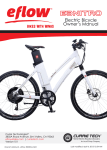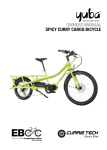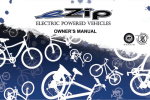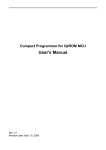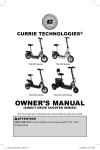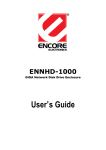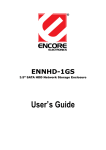Download Currier Tech Ezip Technical information
Transcript
Contents Customer Service.................................................................................3 Technical Information..........................................................................4 Scooter Components...........................................................................5 Scooter Assembly...........................................................................6-11 Tire inflation........................................................................................8 Quick release levers/clamps.......................................................10-11 Scooter Use........................................................................................12 Safety............................................................................................. 13-15 Battery Care.................................................................................. 16-19 Battery charging...............................................................................19 Maintenance.................................................................................. 20-23 Brake adjustment....................................................................... 21-23 Troubleshooting........................................................................... 24-25 Limited Warranty.......................................................................... 26-27 Additional Instructions and Warnings........................................ 28-29 2 e4.5 Owner's Manual.indd, Last Modified: December 28, 2012 10:49 AM PLEASE DO NOT RETURN THIS SCOOTER TO THE STORE. For questions or assistance on assembly, contact Currie Technologies® Customer Service toll free at (800) 377-4532 Monday - Friday 8:00 am - 4:00 pm (PST) Retain this manual along with the original sales receipt. Record the product serial number (S/N), place of purchase and date of purchase below. Model Name : __________________________________________ S/N : __________________________________________________ (Stamped on scooter frame, between front wheels) Place of Purchase : ______________________________________ Date of Purchase : _______________________________________ 3 Technical Information Minimum Rider Age 13 years old Maximum Rider Weight 180 lbs. (81.6 kg) Maximum Speed* 12 mph (19 kph) Maximum range* 5 miles (8 km) Battery 24V 7Ah, SLA Charging time** 4-6 hours *Maximum range and speed varies based on rider weight and terrain **Charge time is based on new batteries charged with a standard charger 4 e4.5 Owner's Manual.indd, Last Modified: December 28, 2012 10:49 AM Scooter Components “Top cap” Brake lever Handlebar Saddle Throttle Seat mast Steering mast Locking pin Quick release On/Off switch Battery & controller compartments (underneath deck) Charger port (XLR-3 plug type) Chain guard with access door for tire inflation 5 Assembling your e4.5 1. Slide the steering mast onto the scooter frame. Make sure the silver locking pin engages, then close the quick release securely to hold the mast in place. See the next section of this manual for more information on properly tightening quick release clamps. 1a 1b Steering mast Locking pin 6 e4.5 Owner's Manual.indd, Last Modified: December 28, 2012 10:49 AM 2. Install the seat mast into the frame. The mast should go all the way down to the base of the scooter, as shown in photo 2a. You may need to twist the mast to work it into position. With the mast fully inserted, twist the saddle so it is facing forward, parallel to the scooter, then tighten the binder bolt as show in photo 2b. When the binder bolt is properly tightened, the seat mast will not be able to twist out of position or pull out of the scooter. 2a 2b 3. Before riding for the first time, you should check the tightness of all nuts and bolts on the scooter. Most important are the front wheel axle nuts, any nuts or bolts around the rear brake, the motor, and the rear wheel. Make sure the brake levers and throttle are secure on the handlebars. If they can be twisted out of alignment, their mounting bolts need to be tightened. 7 Inflating your scooter’s tires Both the front and rear tires on the e4.5 are pneumatic, meaning they need to be kept inflated at the proper air pressure to work properly. Just like a car tire, the proper inflation pressure is molded into the sidewall of the tire. Unlike a car, it is best to inflate your scooter’s tires with a hand pump (usually sold for inflating bicycle tires), to avoid overfilling. To inflate the front tire: 1. Remove the valve cap from the air valve. 2. Add air as needed, checking the pressure regularly to avoid overfilling. 3. Reinstall the valve cap. To inflate the rear tire: 1. Move aside the door on the chainguard covering the valve. Align the tire valve with the hole in the chainguard, and remove the valve cap. 2. Install the supplied valve extender. 3. Add air as needed, checking the pressure regularly to avoid overfilling. 4. Remove the valve extender, reinstall the valve cap, and close the cover door. 8 e4.5 Owner's Manual.indd, Last Modified: December 28, 2012 10:49 AM Attention! Before riding your scooter for the first time, you must connect the battery, located under the deck plate 2 1 3 9 Properly adjusting the steering mast quick release clamp On the E4.5, the steering mast is clamped in place by the force of the quick release cam lever pushing against one side of the clamp and pulling the tension adjusting nut, by way of the skewer, against the other. The amount of clamping force is controlled by the tension adjusting nut. Turning the tension adjusting nut clockwise while keeping the cam lever from rotating increases clamping force; turning it counterclockwise while keeping the cam lever from rotating reduces clamping force. Less than half a turn of the tension adjusting nut can make the difference between safe clamping force and unsafe clamping force. 1. With the quick release clamp in the OPEN position, position the steering mast so that the handlebar is perpendicular to the front axle. 2. Swing the quick release lever into the CLOSED position. Tension adjusting nut Skewer Cam lever open 3. While holding the front wheel in place, grab the handlebar with both hands and attempt to rotate it out of alignment. Closed 10 e4.5 Owner's Manual.indd, Last Modified: December 28, 2012 10:49 AM 4. If you are able to force the handlebar out of alignment with the front wheel, the clamp needs to be adjusted. Holding the quick release lever in the OPEN position with one hand, tighten the tension adjusting nut with your other hand about 1/2 turn clockwise. 5. Attempt to swing the lever into the CLOSED position. If the lever cannot be pushed all the way to the CLOSED position, return the lever to the OPEN position, then turn the tension adjusting nut counterclockwise one-quarter turn and try tightening the lever again. Repeat steps 3, 4 & 5 until proper quick release tension is achieved. 11 Scooter Use Before riding your scooter for the first time, you should fully charge the battery. This may take up to 6 hours. See the section of this manual on battery charging for more information. Turn the scooter on by flipping the power switch on the deck. 1. To get going, just twist the throttle on the right side of the handlebars. 2. To stop, pull the left-hand brake lever to slow the rear wheel. Try not to skid the wheel; the tire can develop flat spots and cause a bumpy ride. In order to ensure your scooter’s battery lasts as long as possible, you should fully charge the battery after each and every ride. Please see the section of this manual on battery care for more information. 12 e4.5 Owner's Manual.indd, Last Modified: December 28, 2012 10:49 AM Safety Guidelines Limitations of Safety and Warning Notices This owner’s manual includes important safety guidelines and maintenance instructions. Failure to read, understand and follow the instructions in this manual may lead to serious injury or even death. INSURANCE NOTICE Your insurance policies may not provide coverage for accidents involving the use of this electric scooter. To determine if coverage is provided, you should contact your insurance company or agent. »» »» »» »» »» This product is intended for use under adult supervision only. Even under adult supervision serious injuries or even death can occur. Always ride within your capabilities and use common sense, do not ride at night. You are using this product at your own risk. Never operate this product at a speed which is too fast for your skills. Always drive at low speed on dusty surfaces. This product is not intended, designed or licensed for roadway use. This product is intended for use outdoors and on a private, closed course only. Ride only on dry, smooth, solid paved surfaces without motor vehicle traffic. Never use this product on roadways (paved, gravel or dirt), sidewalks, driveways, parking lots near motor vehicles, on or near steep inclines or steps, swimming pools or other bodies of water. This product is not regulated by transportation regulations (that is, the Department of Transportation (DOT)) or state law. The laws and ordinances vary greatly from municipality to municipality. It is your responsibility to know and abide by your local restrictions. We recommend you contact your local police or Department of Motor Vehicles to find 13 out about any special laws or rules governing the use of this product where you live. Never operate this product without proper training or instructions. A child under 13 years old should never operate this product. Rider age does not necessarily mean that they are qualified to operate this product. A parent should never allow this product to be used by an individual not having the ability, coordination, maturity, skills and strength to operate it safely and in a controlled manner. Maximum rider weight is 180 lbs (81.6 kg); never exceed it. Rider weight does not necessarily mean that they are qualified to operate this product. Never modify this product through improper installation, modification of existing parts or use of non-authorized accessories. Doing so may result in denied warranty claims. Before every ride, make sure the handlebars are properly secured to the scooter as instructed in the assembly portion of this product manual. This product is designed to be used by only one person at a time. Never carry passengers or allow more than one person to use this product at a time. Always wear an approved helmet that fits and is worn properly when using this product. Also recommended is to always wear knee pads, elbow pads, eye protection (goggles or face shield), gloves, boots, long sleeved shirt or jacket and long pants. Never operate this product barefoot or in sandals as this increases the risk of injury. Always keep both hands on the handlebars (hand grips) during operation. Always drive slowly and pay extra attention when operating on unfamiliar terrain. Always be alert to changing terrain conditions when operating this product. Never operate on excessively rough, slippery or loose terrain. 14 e4.5 Owner's Manual.indd, Last Modified: December 28, 2012 10:49 AM Practice turning at low speeds before attempting to turn at faster speeds. Do not turn at excessive speed as this could increase the risk of injury. Always check for obstacles before operating in a new area. Never attempt to operate over large obstacles, such as large rocks or fallen trees. Do not ride with headphones. They mask traffic sounds and emergency vehicle sirens, distract you from concentrating on what is going on around you, and their wires can tangle in the moving parts of the scooter, causing you to lose control. Do not do stunts, wheelies, jumps or any other type of dangerous riding. They can cause severe injury to you and damage your scooter. Do not lean the scooter excessively as this may allow parts of the scooter to contact the ground and may result in lose of control or damage to the scooter. Do not touch the motor or brakes as they can become hot from use. WET WEATHER RIDING This product is not meant for use in the water (damp roads, puddles, rain, streams, etc.). Never immerse this product in water as the electrical and brake systems may be damaged. BATTERY CHARGER The charger and charger port should be regularly inspected for damage (cord, plug, enclosure, etc.). If damage is found stop using the charger until it can repaired or replaced. The charger is not a toy and should be kept out of reach of children at all times. Always disconnect the charger from the wall outlet and the charger port on the scooter when not using it. Do not charge your battery for more than 24 hours continuously. 15 Battery care Proper maintenance of batteries will maximize their lifespan and capacity. Currie Technologies® warranties your new batteries from the date of purchase only if properly cared for—refer to the limited warranty for details. Currie uses SLA (Sealed Lead Acid) batteries in the E4.5 scooter. This is a very user-friendly type of battery when cared for properly. Care Even with proper care, rechargeable batteries do not last forever. Every time the battery is discharged and subsequently recharged, its relative capacity decreases by a small percentage. You can maximize the life of your battery by following the instructions in this guide. • Batteries should be fully charged immediately when they are received for the full recommended charge times. E4.5 (SLA) recommended charge time: 4-6 hours • Never charge batteries for longer than 24 hours continuously. • Do not mix old and new batteries. Do not mix alkaline, standard (carbon-zinc), or rechargeable (ni-cad, ni-mh, etc.) batteries. • SLA batteries do not have a “memory.” Partial discharge/charge cycles will not harm the batteries’ capacity or performance. 16 e4.5 Owner's Manual.indd, Last Modified: December 28, 2012 10:49 AM • The rated output capacity of a battery is measured at 77°F (25°C). Any variation in this temperature will alter the performance of the battery, and shorten its expected life. High temperatures especially reduce overall battery life & run time. • Always be sure to turn the bike/scooter power switch to “OFF” after each use. If you leave the power switch in the “ON” position, or your product has not been charged for a long period of time, the batteries may reach a stage at which they will no longer hold a charge. • Be friendly to the environment! Be sure to recycle your old batteries at a local battery-recycling center. Do not throw them in the garbage! Check www.call2recycle.org for more information on free battery dropoff locations. Storage When storing your batteries for a long period of time (longer than two months): • Charge your batteries every 90 days to avoid capacity loss. Batteries slowly self-discharge when left unused for a long period of time; if the battery cells are allowed to reach a critically low voltage, their lifespan and capacity will be permanently reduced. • Always disconnect your charger from the wall outlet and battery before storing the battery. • Avoid storing your batteries in extreme temperatures, whether hot or cold. • Batteries are best kept in a cool, dry place. Do not allow batteries to accumulate condensation, as this could cause shorting or corrosion. • The recommended storage temperature for both SLA and Li-Ion batteries is between 32-77 °F (0-25°C). • Avoid exposing the battery to extreme heat (104°F (40°C) or higher) for long periods of time. 17 Battery FAQ Q: Do I need to “break-in” my batteries? A: Yes, it is recommended that you perform a “break-in” cycle consisting of ~ three discharge/charge cycles to allow your batteries to reach optimum performance. This involves three complete discharges and three complete recharges. After this initial “break-in” cycle the batteries will have maximum possible performance and less line voltage fluctuations under load. Q: Is it normal that the batteries get warm when recharging? A: Yes, it is normal that the batteries will become warm to the touch during the recharging process. This is because the increase of internal resistance and lower energy conversion efficiency from electric energy to chemical energy. Q: How long will my batteries last before needing replacement? A: Average battery life depends on use and conditions. Even with proper care, rechargeable batteries do not last forever. Conservatively, an SLA battery will come to the end of its useful life after ~200 full discharge/charge cycles. A partial charge/discharge counts fractionally against those numbers; running the battery down halfway then recharging it completely uses up one half of a charge cycle. “End of useful life” refers to the point at which a battery can no longer supply 80% of its original rated capacity in ampere-hours. After this point, the aging process will accelerate and the battery will need to be replaced. 18 e4.5 Owner's Manual.indd, Last Modified: December 28, 2012 10:49 AM Battery charging Plug the battery charger into a wall outlet, then into the charger port on the neck of the scooter. The indicator light on the face of the charger will turn red, showing that charging has started. When charging is complete, the indicator light will turn green. A full charge will take 4-6 hours, however if the battery is not empty charging may take much less time. Always unplug the charger after use. Always store the scooter with the power switched turned OFF. 19 Maintenance Regularly checking your scooter and performing maintenance will greatly extend its useful life, and ensure the scooter remains safe to ride. Before each ride, make sure that... ...the steering mast quick release is tight, and the handlebar cannot turn away from the wheels. ...the front wheel axle nuts are tight. ...the front and rear wheels are not cracked or damaged. ...the rear brake operates normally. ...the brake lever is tightened securely to bar, and the lever cannot rotate on the handlebar. ...the handlebar clamp bolts are tight, and the handlebar cannot move or twist out of alignment with the front wheel. If the scooter is being used regularly, every month you should... ...clean the drive chain and lubricate it with a light oil. ...check the drive chain for broken or damaged links. ...inspect the frame, especially the steering mechanism for cracks or wear. ...check that the tires are inflated to the pressure indicated on their sidewalls. 20 e4.5 Owner's Manual.indd, Last Modified: December 28, 2012 10:49 AM Brake adjustment Although the brake on your scooter is set at the factory, you may need to adjust it slightly as the brake pad wears over time. Find the rear brake on the left side of the scooter, attached to the rear wheel. The brake barrel adjuster is shown in the photo below. This adjuster simply increases or decreases the tension on the brake cable, setting the brake pad’s initial position. To increase braking power: Turn the barrel adjuster nut counter-clockwise, unscrewing it about 1/2 turn at a time. Spin the rear wheel after each turn of the barrel, checking for brake drag, then use the handlebar brake lever to test stopping power. Pinch nut/bolt Ferrule Barrel Adjuster As the barrel adjuster nut is unscrewed braking power will increase, but if it is turned too far brake drag will occur. The goal of adjusting the brake is to find a setting where the rear wheel spins freely, then stops powerfully when the hand brake is applied. Use caution when adjusting the brake! If the barrel adjuster nut is unscrewed too far, it will become detached and the brake will no longer be effective. If this happens, screw the barrel back into its hole a few turns. 21 Replacing the brake cable: If the brake lever on your scooter becomes stiff and difficult to operate, the brake cable may have become rusted or dirty inside its housing. You can easily replace the brake cable to get back to “like new” performance. The E4.5 uses a standard bicycle brake cable and cable housing that can be purchased inexpensively at any bike shop. To replace the brake cable, first remove the ferrule from the end of the cable with a pair of pliers (see photo on page 21), then loosen the pinch nut enough to remove the brake cable from the brake arm. Pull the cable out of the scooter, starting at the brake lever. 1 Apply a small amount of grease to the new cable if available (to prevent rust), then push the new brake cable through the housing. Secure the “lollipop” shaped cable end into the brake lever (see photo 1), then pull the cable through the lever body. Thread the new cable through the small hole in the pinch bolt. Before tightening the pinch bolt, screw the brake barrel adjuster in completely (clockwise) so it can be adjusted later. Tighten the pinch nut, then install a new ferrule to prevent fraying (a few cents Cable end fits into brake lever body at any bike shop). Follow the steps on page 21 for adjusting the brake to restore normal stopping power. 22 e4.5 Owner's Manual.indd, Last Modified: December 28, 2012 10:49 AM 2 Lever barrel adjuster Cable is drawn through brake lever. Note the gap in the barrel adjuster that allows the cable to pass through. 3 Barrel adjuster is rotated to close gap. Cable housing fits into end of barrel adjuster. 23 Troubleshooting Scooter will not function • Charge battery for the full recommended time (4-6 hours) • Check connections to the scooter controller, located under the deck near the battery. Scooter suddenly stops working during use • Check fuse, located near the controller inside the battery compartment. If the fuse has burned out, replace it with a standard automotive fuse of the indicated amperage. Scooter only runs for a short amount of time • Your battery may have aged past its useful life. See the Battery Care section of this manual for more information • The rear brake may be rubbing, forcing the motor to work much harder than normal to propel the scooter. See the section of this manual discussing brake adjustment for more information. Scooter makes grinding noises under power • Check that the chain is not rubbing the scooter frame or chainguard. • Lubricate the chain (see Maintenance section) After owning the scooter for a while, the brake lever becomes stiff and difficult to operate • See instructions on page 22 for help cleaning or replacing your brake cable. For instructions on more advanced troubleshooting, please call our customer service department in California at 800-377-4532 24 e4.5 Owner's Manual.indd, Last Modified: December 28, 2012 10:49 AM This page intentionally left blank 25 LIMITED WARRANTY EZIP ELECTRIC SCOOTERS Purchased within the United States Currie Tech Corp. D/B/A Currie Technologies (“Currie”) warranties to the original owner of each new EZIP brand electric scooter, when purchased directly from an authorized Currie reseller, to be complete and that the following components will be free from defects in material and workmanship for the period indicated below. WARRANTY DOES NOT COVER NORMAL WEAR AND TEAR, SHIPPING DAMAGE, ALTERATIONS, MODIFICATIONS, MISUSE, NEGLECT OR ABUSE. Warranty EZIP branded electric scooters: Three months (90 days) from purchase date by the original owner. Currie replacement or maintenance parts & accessories: One month (30 days) from purchase date when purchased directly from Currie. Specific Warranty Items Tires and inner tubes are warrantied to be free from manufacturing and material defects for One month (30 days). The tire and inner tube warranty does not include damage from normal road hazards, flat tires, tire cuts and the like, skid wear or blowouts from over inflation or other such misuse, or normal wear. Batteries (factory-installed in an EZIP scooter) are warrantied to the original owner to be free from defects in materials and workmanship for a period of Three months (90 days) from the date of purchase by the original owner. The battery warranty does not include damage from power surges, use of improper charger, improper maintenance or other such misuse, or normal wear. Batteries purchased as maintenance or accessory parts are warrantied for One month (30 days) from the date of purchase by the original owner, when purchased directly from Currie. Items Not Covered Warranties are limited to replacement of parts and/or products determined by Currie, at its sole discretion, to be defective. In cases where multiple components are missing, you may be redirected to the retailer for assistance. Currie will not be responsible for labor costs or repairs. 26 e4.5 Owner's Manual.indd, Last Modified: December 28, 2012 10:49 AM Currie’s Limited Warranty does not cover or apply to the following: Normal wear and tear; any damage, failure and/or loss caused by accident, shipping damage, misuse, neglect, abuse and/or failure to follow instructions or warnings as stated on the product or in the applicable owner’s manual or other printed materials provided with the product; damage, failure and/or loss caused by the use of the product for stunt riding, ramp jumping, competition, offroad use, acrobatics, trick riding or other similar activities, or use in any other manner for which such products were not specifically designed. This warranty does not apply to any products or components, mechanical and/or electrical, which have in any way been altered from their original configuration by any person. Currie will not be liable and/or responsible for any damage, failure or loss caused by any unauthorized service or use of unauthorized parts. The Currie’s Limited Warranty does not cover or apply to any Currie product used for rental or commercial purposes unless the specific product is designated, labeled or marketed by Currie as acceptable for rental or commercial use. The Currie Limited Warranty does not cover or apply to any Currie product sold by a non-authorized reseller or retailer. The Currie Limited Warranty does not cover or apply to any replacement, maintenance or accessory parts not sold directly by Currie to the original retail purchaser. Warranty Claims Those parts and/or products which are determined by Currie to be defective and to qualify for warranty replacement will be provided at no charge, only after a valid warranty claim is processed by Currie Customer Service Department. Warranty claims must be made by the original purchaser by contacting the Currie Customer Service Call Center (800-377-4532) within the warranty period (stated above). Standard Shipping & Handling fees will apply to all orders placed for warranty parts and/or products and will be charged to the customer/warranty claimant at the time said parts and/or products are shipped from Currie. Currie, at its sole discretion, has the option of replacing with a new part, or factory re-certified part. The Limited Warranty stated herein is in lieu of and expressly excludes all other warranties not expressly set forth herein, whether expressed or implied by law or otherwise, including, but not limited to, any warranties for merchantability and/or fitness for any particular purpose. Currie shall in no event be liable or responsible for incidental or consequential losses, damages or expenses in connection with their products. The liability of Currie hereunder is expressly limited to the replacement of goods complying with this warranty or at the sole discretion of Currie to the repayment of an amount equivalent to the purchase price of the product in question. Shipping & Handling fees will apply to all claims made under this warranty and will be charged to the claimant at the time products are shipped from Currie’s distribution center. Currie Technologies®, 3850A Royal Avenue, Simi Valley, CA 93063 1-800-377-4532 27 Addt’l SAFETY INSTRUCTIONS ! WARNING »» »» »» »» »» »» These instructions update the owner’s manual to ASTM F2642 standard. Failure to read, understand and follow the instructions in this manual may lead to serious injury or even death. Do not allow hands, feet, hair, body parts, clothing, or similar articles to come in contact with moving parts, wheels or drivetrain, while the motor is running. Make sure that the areas that the scooter is to be used in is safe and suitable for safe operation. Make sure that all safety labels are in place and understood by the rider. No passengers are allowed on the scooter Make sure that any and all axle guards, chain guards, or other covers or guards supplied with the scooter are in place and in good working condition. Make sure that tires are in good condition, inflated properly, and have sufficient tread remaining. Persons with following conditions are cautioned not to operate the scooter: »» »» »» »» Those with heart conditions Pregnant women Those with head, back, or neck ailments, or prior surgeries to those areas of the body Those with any mental or physical conditions that may make them susceptible to injury or impair their physical dexterity or mental capacities to recognize, understand and perform all of the safety instructions and to be able to assume the hazards inherent in operating the scooter. SAFETY INSTRUCTIONS (INSERT) 28 e4.5 Owner's Manual.indd, Last Modified: December 28, 2012 10:49 AM FCC instructions FCC Warning for the battery charger Warning: Changes or modifications to the charger not expressly approved by the party responsible for compliance could void the user’s authority to operate the equipment. NOTE: This equipment has been tested and found to comply with the limits for a Class B digital device, pursuant to Part 15 of the FCC Rules. These limits are designed to provide reasonable protection against harmful interference in a residential installation. This equipment generates, uses and can radiate radio frequency energy and, if not installed and used in accordance with the instructions, may cause harmful interference to radio communications. However, there is no guarantee that interference will not occur in a particular installation. If this equipment does cause harmful interference to radio or television reception, which can be determined by turning the equipment off and on, the user is encouraged to try to correct the interference by one or more of the following measures: * * * * Reorient or relocate the receiving antenna. Increase the separation between the equipment and receiver. Connect the equipment into an outlet on a circuit different from that to which the receiver is connected. Consult the dealer or an experienced radio/TV technician for help. ADDT’L Maintenance instructionS These instructions update the owner’s manual to ASTM F2642 standard. »» »» Inflate tires to the pressure molded into the tire sidewalls. No lubrication is required except for the chain. Use chain lube. 29 3850A Royal Ave Simi Valley, CA 93063 Phone:+1 800.377.4532 Fax: +1 805.915.4321 www.CurrieTech.com
































